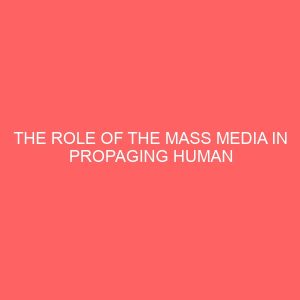Description
CHAPTER ONE
Introduction
One of the greatest social crimes committed in the institutions of higher learning in the country as of today is cultism. It is a social crime which is very rampant in Universities. Colleges of Education and Polytechnics all over the country, It is a social menace which is not restricted to only the institutions of higher learning but that which is a common phenomenon that characterises the entire society the secondary schools are not left behind.
According to Ogunade 2002, cultic activities are sometimes laden with blood. It may be the blood of an animal or that of human beings. He claimed that during initiation rites or during rival group clashes within the University setting, blood flow during which many lives are lost in the process. There are various secret cults now in our institutions of higher learning. They are called different names depending on the institution. There are those cults mostly meant for male students while there are some mostly for the female students. These various cults are usually in conflicts with one another during which many of their lives including those of the innocent nonmembers are lost. This chapter is set out to examine the causes, types and consequences of cultic activities in the Nigerian institutions of higher learning and to suggest ways of eradicating them.
1.1 Background to the Study
Cultism is dated back to 1952, when Wole Soyinka winner of the 1986 Nobel Peace Prize for Literature and a group of friends at the University of Ibadan formed the Pyrates Confraternity with the motto Against all Conventions. The skull and cross bones were their insignia, cultivating a bohemian style that ridiculed the colonial attitudes mode of dress of the day.
This caught on among students and over the next two decades, the fraternity, a nonviolent body, became established in all the tertiary institutions that emerged in post independence Nigeria.
The emergence of campus cults as they are known in Nigeria today began with a split in the Pyrates Confraternity during the early 1970s when a breakaway group formed the Buccaneers Confraternity followed by the emergence of the Black Axe or the NeoBlack Movement. Intergroup rivalry then set in, even though skirmishes between them were limited to fist fights.
The 1980s saw the multiplication of cults in the more than 300 tertiary institutions across Nigeria as new groups such as the Eiye, Vikings, Amazons and Jezebel emerged, bringing with them more intensely violent rivalry. By 1984, when Soyinka initiated the abolition of the Pyrates Confraternity in all tertiary institutions, the phenomenon of violent had developed a life of its own.
By the mid1980s, reports had it that some of the cults have been coopted by elements in the intelligence and security services serving the military government such that they were used as foils to the leftwing student unions which, along with university teachers, were among the only remaining bastions of opposition to military rule. Cultism includes the activities of secret cults or societies that are very rampant in our institutions of learning today. The founding fathers of such societies do not have the mind of carrying out evils but as a pressure group that can monitor and defend the interest of the immorality of students populace without violence. But the activities of the various cults seen day in our institutions are far from the above reasons. They have constituted themselves into gangs of neverdowell set of people. Their mission today is to loot, kill, steal and destroy lives and properties at will. The violence associated with them is reported to be as a result of battles for supremacy among them. They have constituted themselves into a big cog in the wheel of Nigerias education development. Indeed, the growth and maturation of examination malpractice tendencies in our tertiary institutions have been considered as one of the direct fallouts of cultism. Hardly a month passes these days, without reports of deaths of students or staff resulting from cultrelated violence….
INTRODUCTION
1.1 Background of study
1.2 Statement of research problem
1.3 Objective of the studies
1.4 Significance of the study
1.5 Research question
1.6 Research hypothesis
1.7 Definition of terms
1.8 Limitation of the study
CHAPTER TWO
REVIEW OF THE LITERATURE
2.1LITERATURE REVIEW
2.2Effects of Cultism in Nigerian Tertiary Institutions
2.3Solutions to the Menace of Campus Secret Cults and eradication of CULTISM IN THE CAMPUSES
2.4Causes of Cultism in Nigerian Higher Institutions
2.5THEORITICAL FRAME WORK
2.6Summary of literature review
REFERENCE
CHAPTER THREE
METHODOLOGY
3.1 Research design
3.2 area of the study
3.3 POPULATION OF THE STUDY
3.4 SAMPLE AND SAMPLING TECHNIQUES
3.5 Measuring instrument
3.6 method of Data collection
3.7 METHOD OF DATA ANALYSIS
REFERENCE
CHAPTER FOUR
DATA ANALYSES AND PRRESENTATION
4.1Data analysis
4.2Results
4.3 Discussion
CHAPTER FIVE
SUMMARY CONCLUSION AND RECOMMENDATION
5.1 Summary
5.2 Conclusion
5.3 Recommendation
Bibliography
Appendices








Reviews
There are no reviews yet.